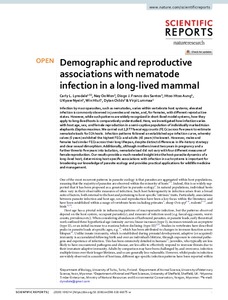Demographic and reproductive associations with nematode infection in a long-lived mammal
Lynsdale C.L.; Mon N.O.; dos Santos D.J.F.; Aung H.H.; Nyein U.K.; Htut W.; Childs D.; Lummaa V.
https://urn.fi/URN:NBN:fi-fe2021042826974
Tiivistelmä
Infection by macroparasites, such as nematodes, varies within vertebrate host systems; elevated infection is commonly observed in juveniles and males, and, for females, with different reproductive states. However, while such patterns are widely recognized in short-lived model systems, how they apply to long-lived hosts is comparatively understudied. Here, we investigated how infection varies with host age, sex, and female reproduction in a semi-captive population of individually marked Asian elephants Elephas maximus. We carried out 1,977 faecal egg counts (FECs) across five years to estimate nematode loads for 324 hosts. Infection patterns followed an established age-infection curve, whereby calves (5 years) exhibited the highest FECs and adults (45 years) the lowest. However, males and females had similar FECs across their long lifespan, despite distinct differences in life-history strategy and clear sexual dimorphism. Additionally, although mothers invest two years in pregnancy and a further three to five years into lactation, nematode load did not vary with four different measures of female reproduction. Our results provide a much-needed insight into the host-parasite dynamics of a long-lived host; determining host-specific associations with infection in such systems is important for broadening our knowledge of parasite ecology and provides practical applications for wildlife medicine and management.
Kokoelmat
- Rinnakkaistallenteet [27094]
